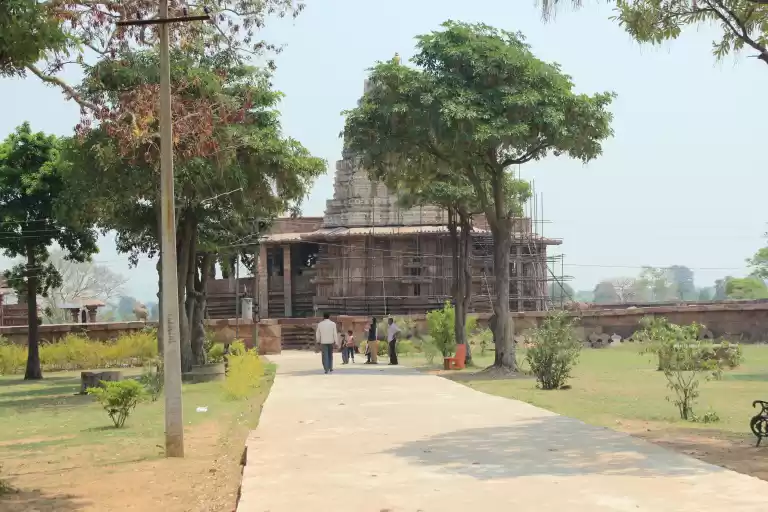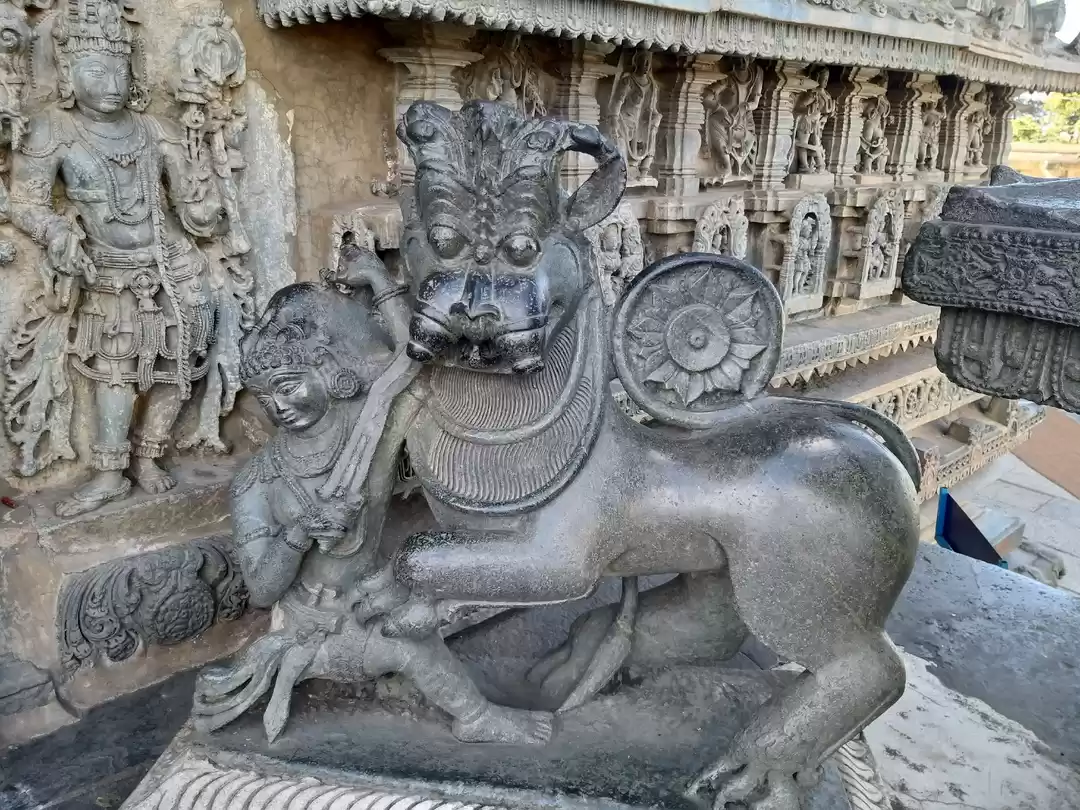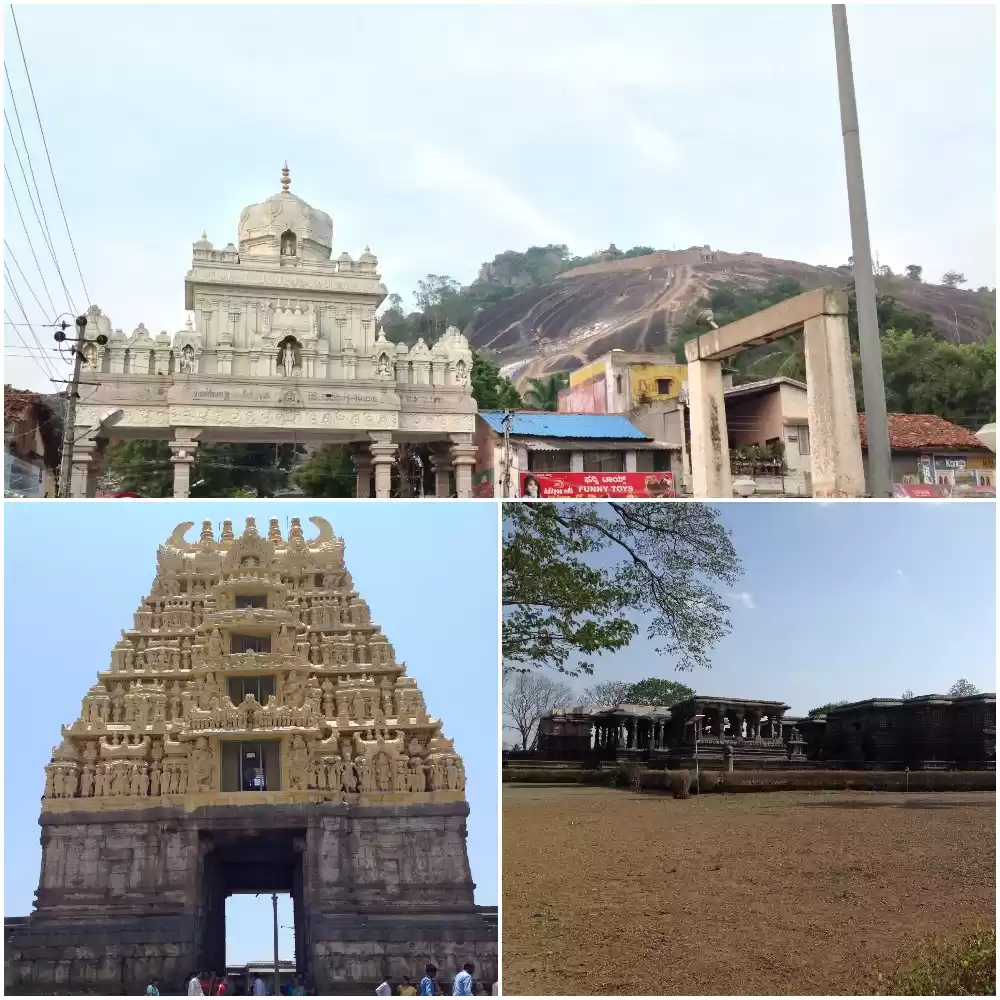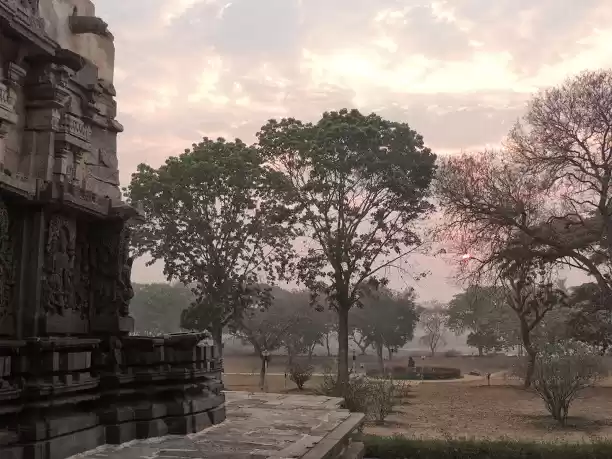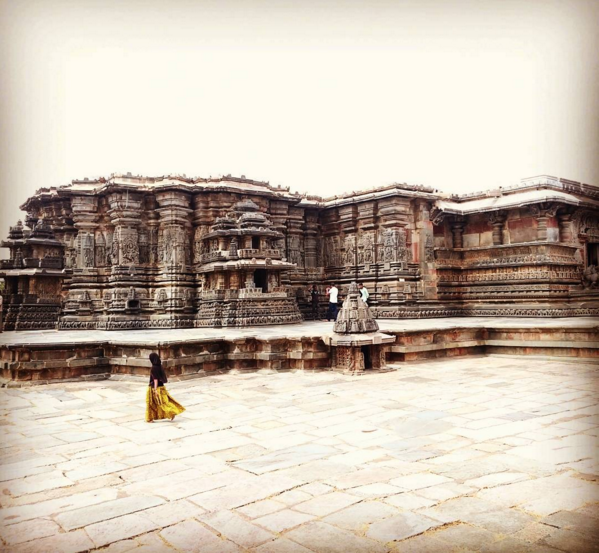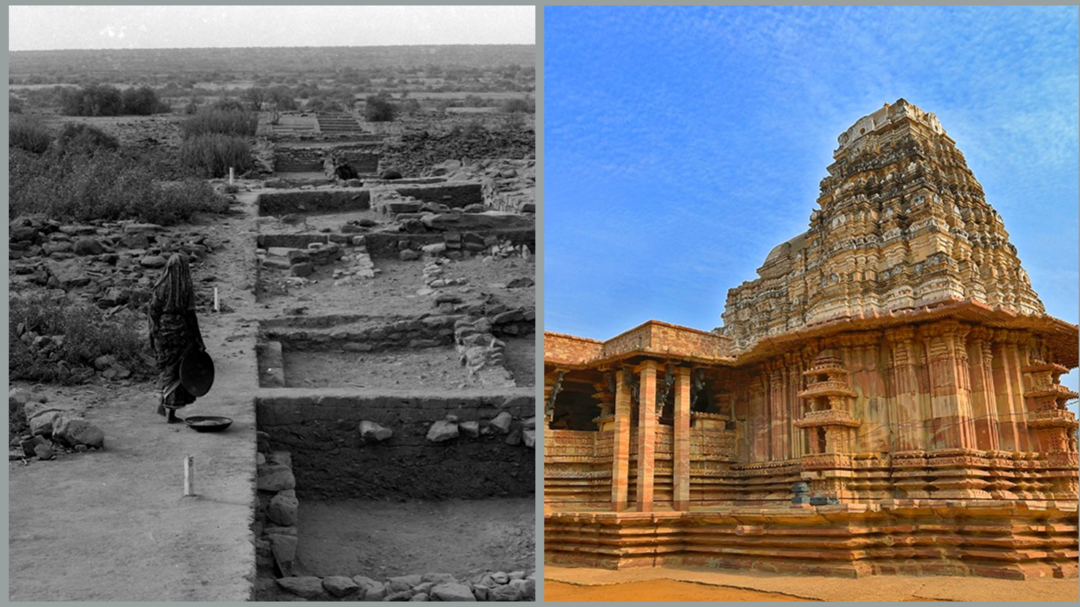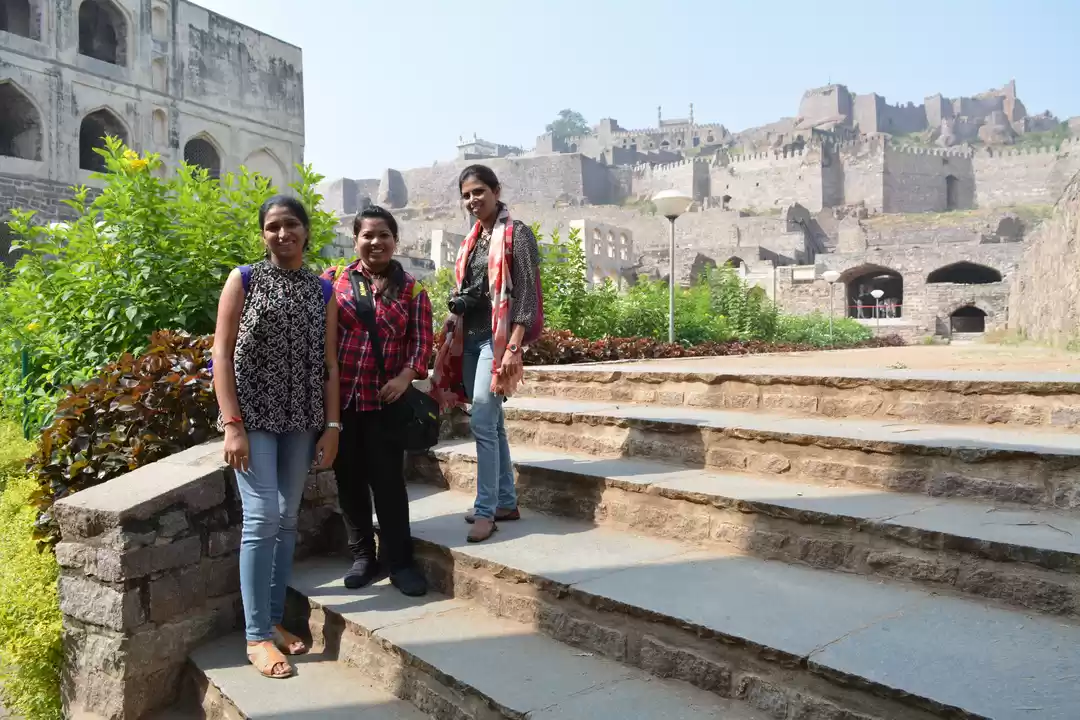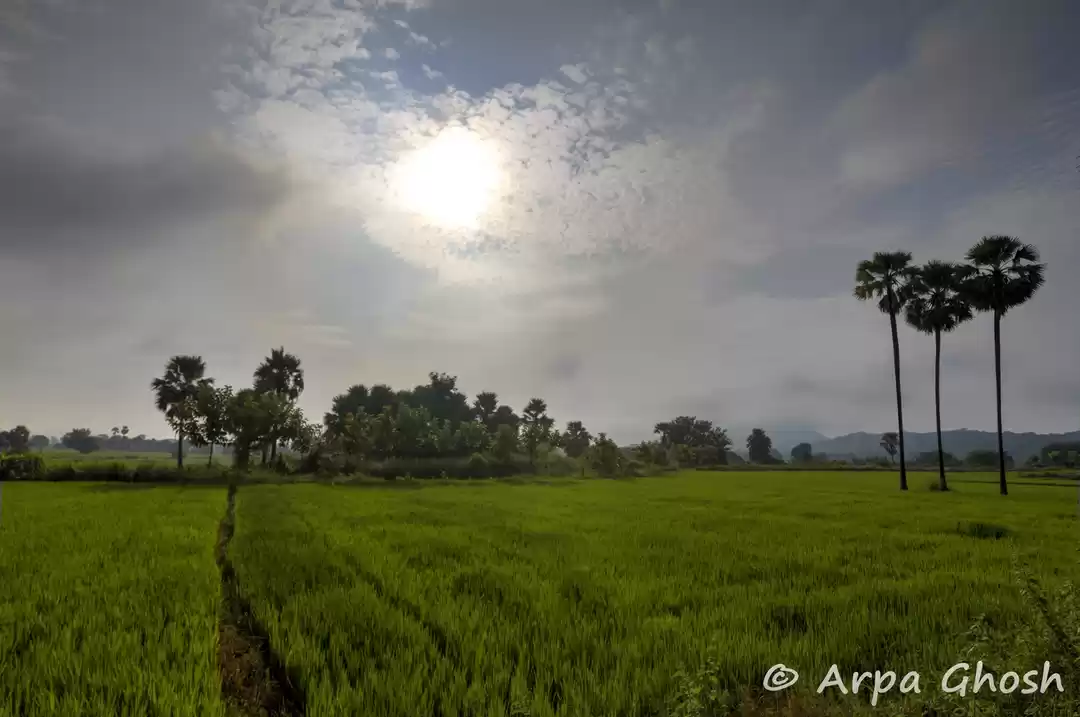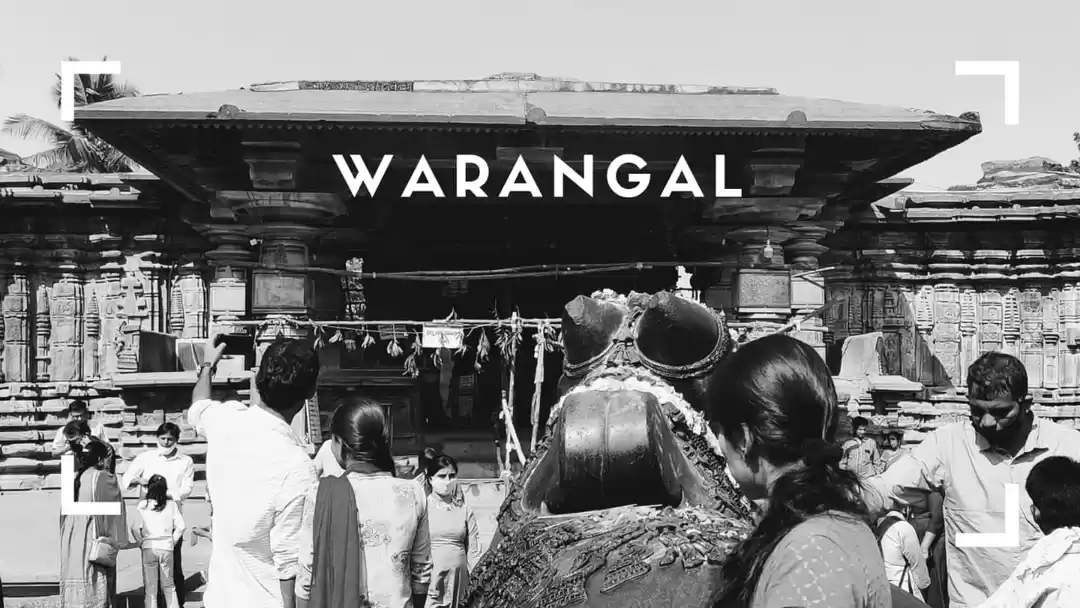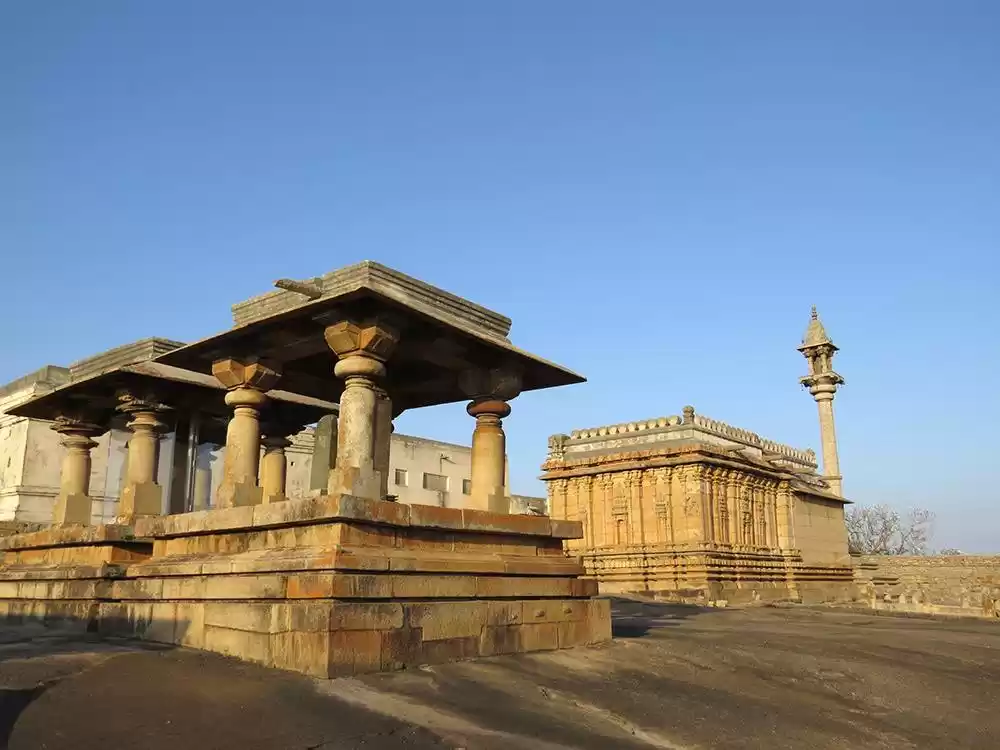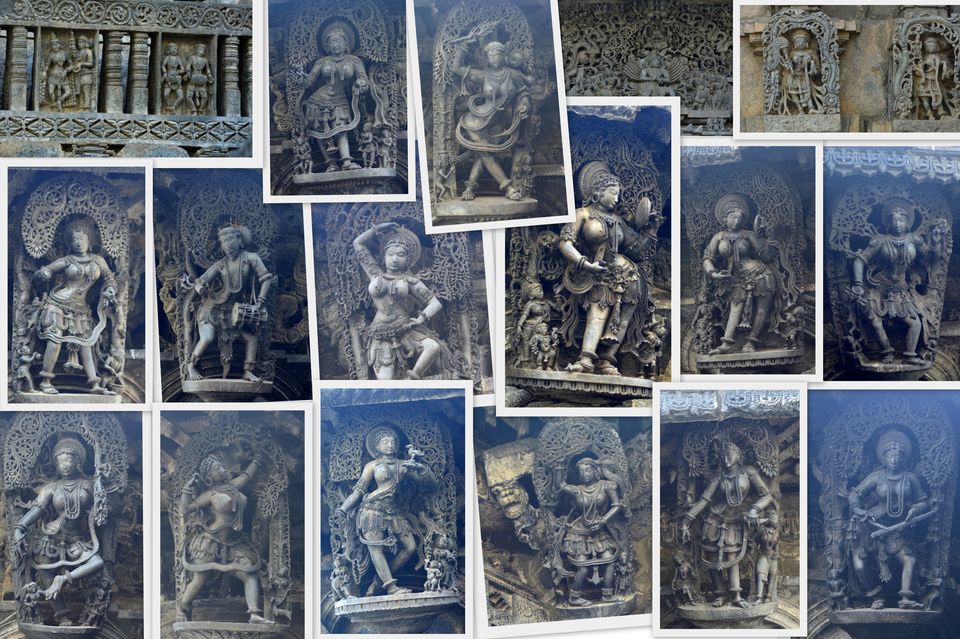
Fascination for the Indian Architecture began with Badami-Banashankari – Mahakuta – Hampi-Pattadakal-Aihole Trip (4 years back). The quest to know more and to see the creativity in carvings about these forgotten kingdoms led me from Chalukyas to Kakatiyas to Hoysalas. Two years back, I had been to Warangal, Hyderabad & Lepakshi. While listing out the to-travel list of all the remaining places in different states, I came across Ghanpur Group of Temples, it looked like ruins, still something kept attracting to this ruins and a whole plan was drafted on basis of this place.
Hyderabad – Warangal – Ghanpur – Shravanabelagola – Doddagaddavalli – Halebidu – Belavadi – Arsikere : 5 days trip.
I had 5 days Diwali holidays, added 2 more days. Checked out on few friends, they couldn’t leave home, because of Diwali. I had a choice either to postpone or to go Solo.
Then, Solo was it!
I never thought that I would ever go on a Solo trip, basically, lacked the confidence and also, various factors like travelling alone to far-off secluded place like Ghanpur or reaching late night in Warangal made me think over and over again. But wasting holidays at home was scarier than going Solo. Also, 7th Nov, being my birthday, I wanted to try something which I had never done before. Watching and reading posts about so many women travelling solo across globe in the “The Solo Female Traveller Network” in Facebook instilled some positivity about this adventure. Still, I kept postponing the plan till 10 days prior to Diwali. Also, by luck or fate, the tickets were available on all lines as per my plan. Booked all tickets in 3AC (splurged a bit) and waited for the day to arrive.
Started on 7th Night November, 2018 at 11.00 pm, boarded the Duronto for Secunderabad.
8th November 2018: Reached perfectly on time by 11.30 am, next day at Secunderabad Railway Station. I had train to catch to Warangal at 4.00 pm and main purpose of being in Hyderabad was Biryani and I had planned to feast on Biryanis for both lunch and dinner . First thing was to deposit the bag (Rs.25) in the Cloak Room. After unloading the haversack, I used the Pre-paid AC waiting Room (Rs. 25 per hour) to freshen up. It was good and squeaky clean. Inquired about further transportation to Hyderabad. The Attendant said there is a local train to Hyderabad. I took the local train ticket (Rs. 10/-) and waited. After waiting for 20 minutes, watching two local trains leave (for some other destination), I enquired at the enquiry counter on the platform. He said, it will come at 1.30 pm. And, it was like mid noon. Instead of wasting time, I hired an auto (300). I knew it was bit on higher side but then, I couldn’t bargain much.
I spent 20 minutes in Photography, before leaving for Laad Bazaar which was hardly 5 minutes walking from there. Shopped for some bangles (Another favorite place in Hyderabad), got out from Charminar Side, hired an auto (150) to Café Bahaar (the best biryani restaurant). There was a waiting queue for 15 minutes, being the lunch time. Had the satiated meal and left for Secunderabad station by 2.45 pm. Again, another auto for 150. Halted at Karachi Bakery to buy some biscuits. I reached Railway Station at 3.15 pm. I had ample time, before the train left. Released the bag from Cloak Room. Till then, train was already on the Platform. Boarded the Satavahana Express. I had booked the Cabin Chair seats. Almost dozing off the entire way, reached Warangal by late evening at 7.30 pm. I had checked out some hotels online, and named one to the auto driver (70). The hotel was closed. He took me to another hotel, which was full. Finally, I settled for Vishnu Lodge. I was bit skeptical about staying there, but fortunately, the rooms were cleaner and closer to station (700). I had dinner and slept for the night.
9th November, 2018: I woke up early by 6.00 am, got ready by 7.00 am, informed the guy at the reception, which was in basement car parking area, that I will checkout at 1.00 pm. I got the bus from the Warangal Bus Stand which was near Railway Station, instead of going to Hanamkonda, I got down at Mulugu Road Junction(Wrong bus). Luckily, got an empty shared auto(15) till Hanamkonda Bus Stand. From here, buses ply regularly to Mulugu or Palampet. These villages are closer to Ramappa or Ghanpur. Since, I was pretty tight on time, I preferred an Auto, because of an earlier experience of very slow driving by State Buses in Hyderabad trip. Very few people understand Hindi here, communication was a bit problem but then saying Ramappa was enough. I hired an auto for a round trip (1200). Ramappa Temple is at 80 kms from Warangal. Ghanpur is further 15 kms from Ramappa. Seemed like a good bargain.
I was fascinated by Ramappa Temple, during my last visit in Hyderabad Trip. Visiting it again was like reliving the memories of its fine artworks. Before leaving the Warangal City, I enquired with the driver, if there is a good place to eat Breakfast. Being a local, he took me to a small stall, and honestly, it was the tastiest hot Idli with chatni, I ever had. Look out for this guy, who is located just opposite, on a lane to Sharath Eye Laser Hospital. There were many smiling faces around, because I looked every bit a traveler and looking at my Tripod, he enquired about my destination and my origin. They were bit surprised about lone lady coming all the way from Mumbai. After the acknowledgement and greetings, we left for Ramappa Temple.
Ramappa temple is also known as Ramalingeshwara Temple. The uniqueness of this temple is, it is the only temple in India which is named after its Architect / Sculptor Ramappa. It is built on 6 feet high Platform. It consists of Garbhagriha, An Antarala and Maha Mandapam. It was built during Kakatiya Regime. There is a Nandi Mandapam facing the temple of Lord Shiva. There is 9 feet Shivalingam in the Garbhagriha. The entire outer walls, inner walls, ceilings, pillars are carved intricately with various dance forms, musical instruments, scenes from Ramayana, Mahabharata and other ancient texts. Earthquakes and various other calamities had taken its toll on this temple. The floor is raised in some areas, due to past earthquakes over the centuries. Still, the temple stands tall in its glorious beauty. After spending almost an hour, went ahead to Ghanpur Group of Temples which was further 15 kms away. In next 15 minutes, I arrived at Ghanpur Ruins.
Ghanpur Group of temples is another marvelous work of the Kakatiyan Era. It was built during the reign of King Ganapatideva of Kakatiya Dynasty. The main Shiva temple is surrounded by 19 smaller temples each with Garbhagriha & an Antarala. The craftsmanship of the ancient sculptors on the walls of these temples is exemplary. A lone priest was there, who performs the puja in the central main temple. On watching me climbing the steps, he opened the locked door of the temple, showed the Garbhagriha area, performed a small puja for me (I didn’t expect that, not a puja fan though). There was a big shivling in the Garbhagriha. Over the years, the pillars, walls have fallen over. I went around looking at the fallen pillars, scattered stones, broken temples which were lying in ruins. It was worth a visit to see such a long lost architecture, unfortunately in dilapidated state now.

I asked the driver to head back to Warangal, but on the way asked him to stop at 1000 Pillars temple. I had been to this temple earlier and had the pleasure to photograph the interiors of this majestic temple. This time, they have restricted the photography access, which was rather disappointing. I went around, clicked the facade and returned back. This temple is also another masterpiece of Kakatiyan Era.
I requested the driver to drop me back to hotel rather than Hanamkonda, for which again, he charged Rs. 70/-.
Checked out and boarded the East Coast Express train at 2.30 pm from Warangal Station. Reached Secunderabad at 5.30 pm. Next leg of Journey was from Bangalore.

I had booked the Garib Rath from Secunderabad to Yesvantpur, which was supposed to arrive at 08.20 pm. Having some time to spare, went to Pre-paid AC waiting Room and played some rounds of PUBG, ordered Biryani from Paradise via Zomato. Boarded the train, had dinner. There was family going to Bangalore for wedding, since majority were ladies, shared some travel stories. I assumed their dialect to be Konkani. During conversation, they informed me that it is called “Tanjore Marathi”. I was bit taken aback, since Tanjore is in Tamil Nadu and connection between two was odd. There was a long background story, to summarise, their ancestors settled in Tanjore hence the change in dialect.
Ended the Part of Telangana trip here, further travelling to Bangalore!
10th November 2018: I bid them adieu in the morning when the train reached at 9.00 am. at Yesvantpur Railway Station. Hired an auto to travel to Bangalore Majestic Bus Stand (100). As soon as I reached there, bus was already on the Platform, ready to go to Channarayapatna, which was 12 kms from Shravanabelagola. There are no direct buses to Shravanabelagola. Channarayapatna is the main Bus Stand from where, many connections are available to Hassan, Belur, Chikmagalur etc. It was almost 3 hours Journey. Thankfully, bus took a halt of 15 minutes for break. I had a quick breakfast. Reached Channarayapatna Bus Stand in the afternoon. Got another Bus to Shravanabelagola, it was another 20 minutes ride. After getting down in the quaint village of Shravanabelagola, I looked around for Dharmashala. It was next to the Bus Stand. Booked a Room for 1 night (Rs. 325). It was clean room with basic supplies. I got ready by 3.00 pm to explore the two hills – Chandragiri (Chikkabetta)& Vindhyagiri. Chandragiri is smaller version more of a Hillock with 200 steps while the main statue of Bahubhali is on Vindhyagiri and has around 600 steps.
I realized the mistake of leaving in the afternoon, because one has to climb without footwear. I walked opposite to Bus Stand to climb the Chandragiri first. Kept the floaters at the base and started climbing the rocky stairs. The Rock was hot, scorched my feet. Managed to reach in 10 minutes, because I almost ran for first 100 steps trying to avoid the burns. One can view entire village including the Kalyani (lake), located in centre of Village. There are many Jain Basadis on the top (majority of them are on this hillock). All grouped together. All the Basadis are enclosed in a walled fort area. Temples are built in Dravidian style of Architecture.

There are around 14 temples, similar to one another. At the entrance there is a Kuge Brahmadeva Pillar called as Manasthambha. It has a pavilion at the top that has figures, that face the four directions. Chandragupta Basadi – constructed by Emperor Asoka in 3rdCentury BC, dedicated it to his Grandfather Chandragupta Maurya. Savatigandhavarana Basadi was constructed by Queen Shantala, wife of Hoysala King Vishnuvardhana.

There are many inscriptions found in Halegannada (Old Kannada) scattered and protected by glass pane on top of it. Here, three kids befriended me, following everywhere, finally clicked some photos with them, which I have to courier it to them later. With profound happiness, I climbed down, reaching at 4.30 pm.
I dropped the idea of climbing Vindhyagiri, because it would have been very tiresome for next day, which I had kept for Belur & Halebid (my about to be topmost favourite place displacing Hampi :)). Came back to Dharamshala, rested till 6.30 pm. Since, I had skipped lunch, I went around looking for dinner, settled for toast sandwich & Samosa Pav. Both were good. There are some good vegetarian restaurants at the foothill of Vindhyagiri. Rested for the day. Hoping feet would be normal by tomorrow morning.
11th November 2018: Next day, early morning checked out by 7.00 am from Dharamshala, got bus till Channarayapatna. Took another bus to Hassan, which was ready to depart. Reached Hassan by 9.00 am. Took auto till Hotel Suvarna Regency, booked a room for a night (1300). Since, breakfast was complimentary, I was given a coupon for breakfast in the adjoining restaurant, which was part of Survarna Regency. Left at 9.30 am for sightsee. I hired an Auto for a round trip of Doddagadavalli, Belur, Halebidu & Belavadi (Rs. 1000). First stop was Doddagaddavalli, located at 15 kms from Hassan.
The Lakshmi Devi temple of Doddagaddavalli was further 5 kms from the main Road. It is a 12th century temple built by King Vishnuvardhana of Hoyasala Dynasty. An example of Chatuskuta (four shrined – Quadruplet) order of temples built during Hoyasala period.
The door guarded by Vaishnava Dwarpalakas was closed, since it was unlocked, I gave a slight push and it opened. I don’t know why, but I got an eerie feeling, when I saw those two almost 6 feet Vetalas facing each other in the Sukhanasi area, guarding the Navranga shrine which was dedicated to Kali.

I went to opposite shrine dedicated to Vishnu. The other two shrines were of Bhutanatha (Shiva) & Laxmi Devi. I took some photos and came out and closed the door. Immediately, the temple priest came running and opened the door again. He asked me whether I saw the murtis. I replied affirmatively. I felt like going again, I went in, he explained to me that this Kali is saumya (calm) form, the ugra (angry) form is in Kolkatta. I told him I have never seen vetalas like this before. He laughed. He said the speciality of this temple is all four of them Shiva – Shakti & Vishnu – Laxmi are in same building (hence, Chatuskuta). I was happy to see such a unique, beautiful temple full of carvings. I left after 30 minutes. Next stop was Halebidu also called as Dwarasamudra or Dorasamudra.
Some basic information before the pleasant architectural spell hits you. Hoysalas are almost 1000 year old dynasty. The kings who shaped this dynasty are Vishnuvardhana Hoysaleshwara & Veera Bhallalla (Grandson). They separated from Chalukyas to build their own independent state. More than 1500 temples were built in 958 centres during their period, most famous of them are Belur, Halebidu & Somnathpur. Main connection to these places is Hassan, which is a 11th century town dedicated to Hassanamba, represented by an Ant Hill. Belur was originally called as Velapuri and was capital (later) of Hoyasalas, located on banks of River Yaguchi. First capital was Halebidu.

Being Sunday, crowd was expected to visit Halebidu, many people come from Bangalore as a one day trip. Halebidu took my interest in architecture & carvings to another level beyond Hampi, it is a MASTERPIECE of carvings. Halebidu was the first capital of Hoysalas, later shifted to Belur. Most famous ornate temples are Hoysaleshwara & Kedareshwara Temples.
These temples are dedicated to Lord Shiva. Around 500 mtrs away from Hoysaleshwara, there is one more beautiful Jain Basadi dedicated to Shantinatha & Parshavanatha built during 11th Century. Further to that is Kedareshwara. Both these are usually missed by regular tourist. The temples were built (completed) in 12thCentury and ransacked and destroyed in 14th century by invaders, however the artwork remained intact, thankfully. These temples were built from Soapstone (metamorphic rock), hence easier to carve fine details.
Hoysaleshwara Temple is actually a Twin temple, built together, one as Hoysaleshwara & another as Shantaleshwara with respective huge Nandis opposite to shrines.

Name was derived from King Vishnuvardhana Hoysaleshwara, who built this temple and Shantaleshwara for Shantala Devi – his Queen. Hoysaleshwara is the most beautiful ornately decorated temple I have ever seen. There are four porches for entry and each entry has extensively adorned actually bejeweled Dwarpalakas. There are more than thousand figurines around the wall.

The temple is built on a star shaped Platform (regular feature of Hoysalas) and has numerous decked pillars in the hall area. The temple façade has layered Frieze, each layer starting from bottom with Elephants which symbolizes Strength, followed by Lions for Courage and Horses for Speed, thereafter the dance forms, mythological animal, followed by various designs and scenes from Mahabharata, Ramayana and other mythological epics.

This layer runs throughout the façade encircling the temple. One has to watch and study each picture in detail to understand the intricacies of the expression, jewelry and importance of figurines
I was simply stunned when I saw Krishna lifting Mount Govardhan (note the detailing here) and Ravana lifting the Mount Kailash (found in other hoyasala temples too). The detailing was so fine. Instantly, I fell in love with the art of Hoysaleshwara temple. I actually wanted to scream out, that I found something so beautiful, so unique that I wanted to share it with the whole world. (That day my selfies came so pretty happiness radiated from face).
There is a Garuda Stambha, a pillar which depicts the history of the bodyguards. It is said that the bodyguard would commit suicide if the master died before them. This pillar pays homage to bodyguard named Kuruva Lakshma who killed himself after his master died. The event is narrated on pillar.
After being dazed by the stunning beauty of Hoysaleshwar, I enquired about Kedareshwar. It was about 1 kms away.
On the way, stopped over for Jain Basadi . King Vishnuvardhana was follower of Jainism who later converted to Vaishnavism, although his wife continued Jainism and helped in construction of many Jain temples during that period.

The Jain Basadis have two temples in its complex. Parshvanatha Basadi and Shantinatha Basadi. the architecture of Parshvanatha Basadi is remarkable. Noted for its beautiful navaranga halls and exquisite carvings on the lathe turned pillars.
The temple has a Ardhamandapa and a Mahamandapa with a monolithic of almost 18 feet Parshvanatha deity. In the mahamantapa, there are sculptures of Yaksha and Yakshi Padmavati. Also, There is a cranny for idols of 24 tirthankaras in the temple.
Shantinatha Basadi consist of a garbhagriha, ardhamandapa, mahamandapa, large granite pillars with the inner sanctum consisting of a 18 feet Shantinatha deity.
Adinatha Basadi is a small austere temple consisting of garbhagriha, mandapa with the image of the deity Adinatha and the Hindu goddess Saraswati.
Further, 500 mtrs, there is a Kedareshwara temple, a Trikuta temple, dedicated to Shiva in the form of Kedareshwara. This temple was built during 1220 AD under the Hoysala rule. The temple entrance is locked and is under renovation.
There is a four Star shaped pillars on either side of entrance towards Navaranga, intricately carved Pillars, Navranga has four bell shaped pillars with a decorated ceiling. The main Garbhagriha has a Shiva Linga. The outer wall of the temple has eight railings or friezes, similar to Hoysaleshwara, starting from Elephants at the bottom, followed by soldiers on horses, beautiful designs in the form of creepers and flowers.

Thereafter, the Hoysala emblem in some places and lions or vallis, then the creepers, followed by episodes of Ramayana, Mahabharatha, Bhagavatha and other Mythological series. There are many scenes like Samudra Manathan, Bhishma lying on bed of arrows, Ravan carrying Mount Kailash, episodes from Prahlad Chapter, Abhimanyu and Chakravyu. Top rows mostly consists of Makara (vallis or mythological creature and Hamsas or Swans. There are life-like images carved on the walls of Lord Shiva, Vishnu, Brahma, Lakshmi, Saraswati, Varaha, Ganesha etc.
Just like Hampi, here the corner images display 3 Dimensions, wondering the precision and imaginations of the craftsmen during that era.
The figurines are very expressive in every form. Importance is given to the expressions in dance forms, holding weapons or the graceful postures while standing or sitting. I didn’t feel like leaving the place but then more places were on the itinerary.
I was hopeful, that again I will visit this place and dedicate a whole day to absorb the creativity of this place. Halfheartedly, I left Halebidu at 1.00 pm. Took half an hour to check out the Jain Basadi and Kedareshwar temples.
Belavadi or Ekachakranagara was around 12kms away from Halebidu, and I had read about beguiling architecture of the Veeranarayana Swamy Temple. This was also a Trikuta temple built by Veera Ballala II in the 13th century and is considered to be the best examples of Hoyasala architecture. The entrance has elephants on both sides.

Here the main deity Sri.Veeranarayana is with Four arms standing on a lotus (8 ft tall – older shrine) is in the center facing East, Sri.Venugopala Krishna, leaning against a tree, playing his flute, surrounded by Shravan Kumaras, Gopikas, Cows, Gopalas etc. with Rukmini and Satyabhama on either side (8 ft Tall) facing North and Sri.Yoganarasimha (7 ft tall) in sitting posture, holding the Shankh & Chakra with Sridevi & Bhoodevi on either side, is facing South. The huge navaranga between these three temples is filled with carved Pillars and ceilings illustrating stories from Bhagvadgita. God). The dashavathara is carved on the prabhavali. During circumambulation of the temple, similar to Hoysaleshwara temple, there were various images of Ganesha, Shiva, Parvati, Vishnu in various avatars. Also, I found the carving of Ravana lifting Mount Kailash here too.

Left Belavadi by 2.00 pm for Belur. It was another 45 mins journey. On reaching Belur City, I asked the auto driver to stop for lunch. By 3.00 pm, I was at Belur Chennakesava Temple. The Gopura resembled the grand Vitthala Temple of Hampi. The complex had Main Chennakesava Temple in the centre, Kappe (Frog) Chanigaraya temple, Sowmyanayaki temple, Ranganayakai temple, Pushkarni and a Dancing hall.
King Vishnuvardhana started constructing the temple in 1117 AD and literally took more than 100 years. It was eventually completed by his Grandson. According to some theory, Vishnuvardhana was celebrating his famous victory against the Chola dynasty, in the battle of Talakad (1116 AD), which resulted in the annexation of Gangavadi (modern southern Karnataka) by the Hoysalas. Another theory points to Vishnuvardhana’s conversion from Jainism to Vaishnavism (a sect of Hinduism) after coming under the influence of saint Ramanujacharya, considering this is a predominantly Vaishnava temple in sculptural iconography.

The image of the lion/tiger subduing the elephant is everywhere in the main temple. The elephant represents the great Cholas and the lion/tiger represents the Hoysala kings.
There is no fees for entry, but when you are inside the temple and start clicking, you will be charged Rs. 30/- by a lady who is also the in-charge of lights and on request she actually puts on the light facing the ceiling and if you got whole day, you can just sit there and watch the finer details on the ceiling. Offcourse, I was again dumbstruck for the second time in the day. The repeating subject was Ugra Narasimha, seen everywhere. Since, it took a century to build, it is said that there were many contributors to the designing of the temple. This temple is a personification of fine Art, intricately detailed, every sculpture is bejeweled, details of war, expressions, weapons, animals, flowers. Just damn perfect!
There are several Shilabalikas / Madanikas on the outer and inner pillars and walls. Each of them inspired by the Queen Shantala Devi. Right from regular routines of grooming, playing instruments to dancing, to hunting all are depicted gracefully.

Darpana Sundari (Beauty with mirror) and lady talking to parrot, huntress etc. and all other idols made me circumambulate the temple three times, each time finding something new to capture and admire.
(Story behind Kappe Changraya Temple is as follows: Jakanachari left his family and entered the services of the various kings of Hoyasalas and produced works by which, his fame is upheld even today. His son Dankanachari grew up and decided to go in search of his father and reached Belur. At Belur, the Chennakeshava temple was in the course of being erected, where the young man remarked that one of the images had blemish. Challenging this remark, the sculptor, who was none other than his father Jakanachari vowed to cut off his right hand, if any defect was to be found in the image.

In order to test this, the figure was covered with sandal paste and to everyone’s surprise ,the paste dried everywhere except on the navel. On further examination, a cavity was found which contained a frog, sand and water. This way, the idol got the name of “Kappe Chanigaraya”(Kappe=Frog in Kannada). He had no choice but to cut off his right hand as per his word. On further inquiry about the boy, they became aware of the relationship between the sculptor and the boy. – Sourced from net).
After visiting the Sowmyanayaki temple, Ranganayakai temple, Dancing Hall, I walked through the Pillared walkway which had several broken pieces of idols finishing off the Belur visit with Pushkarni (Pond). It was 5.00 pm. Time to head back to the Hotel in Hassan. Legs were paining, the plan to drop the Vindhyagiri Hill was perfect or else, it would have been a very hard task to complete these masterpieces in a day. As soon as I reached Hassan, I looked out for ATM, after finding no cash in almost 6-7 ATMs, I found a working ATM. I wondered how people in such cities manage when we are thinking of Digital India. Had dinner and retired for the day. Tomorrow was last leg of the journey. I hired the same Auto (600) for next day to drop me to Arsikere Station, offcourse with stoppages in some places.
Next day I got up late, had breakfast by 9.00, checkout by 9.30 am. First Stop was Harnahalli, which was like 1.5 hrs away from Hassan. Roads were bad.
After reaching the village, a small road to the left lead to the Lakshmi Narsimha temple – Unfortunately, the temple was closed. I was guided to the Priest’s home, the lady in the house said that the Priest has gone for some puja in the next village and will be back by an hour. In the meantime, I thought of visiting the other lesser known temple in the village. Someshvara temple was just opposite to this temple. The Kalasha could be seen from the main road. There was market outside, and the overgrown vegetation almost seemed to cover the temple. There was lock on the main gate. An elderly local asked me to jump in through the space on the compound wall. I looked around, I was the lone person, who would be in the complex of that temple. Without hesitating, I climbed the wall gap and jumped in.

The vegetation growth is trying to engulf the whole area. Looked like the neglected counterpart of the otherwise well known temple on the opposite side. It has similar design and there was that mural of Ravana carrying Shiva-Parvati on the Mount Kailash here too on the back side. After circumambulating the temple, since the main door was closed, I went back to the main gate. There was a guy who was curious about my presence. After the greetings exchanged, I headed back to the main road. Reached Arsikere in next 20 minutes. There was a Isvara Temple, that I was interested in because of stellate roof. It had a unique star shaped mukhamandapa with two opposite entrances located between mukhamandapa and mahamandapa. The garbhagriha houses a Shiva linga and the sukhanasi, a couchant nandi.
On the left side there is a double shrine called as Halavukallu devasthana, simple with minimal decoration. There is a common hall for both. Both these temples have a Shiv Linga in the garbhagriha and open sukhanasi.
By 1:00 PM, I was free and asked the auto driver to leave me at the Arsikere station. I was early, because the train was at 15:40 and waited in the waiting room, boarded the train and reached Hubbali Railway Station by 21:30. I had booked a bus to Mumbai from Hubbali. Bus arrived late by 12.00 midnight and reached Mumbai further late by 12.00 noon. Concluded the Solo trip with so many awe inspiring memories.
I never thought it would be so easy, only thing needed was to step out, rest all just happened with flow!
Frequent searches leading to this page:-
4 days trip from hyderabad, hyderabad tour package for family, hyderabad tour plan, 2 nights 3 days package from hyderabad, hyderabad itinerary for 5 days, bangalore to telangana distance



















